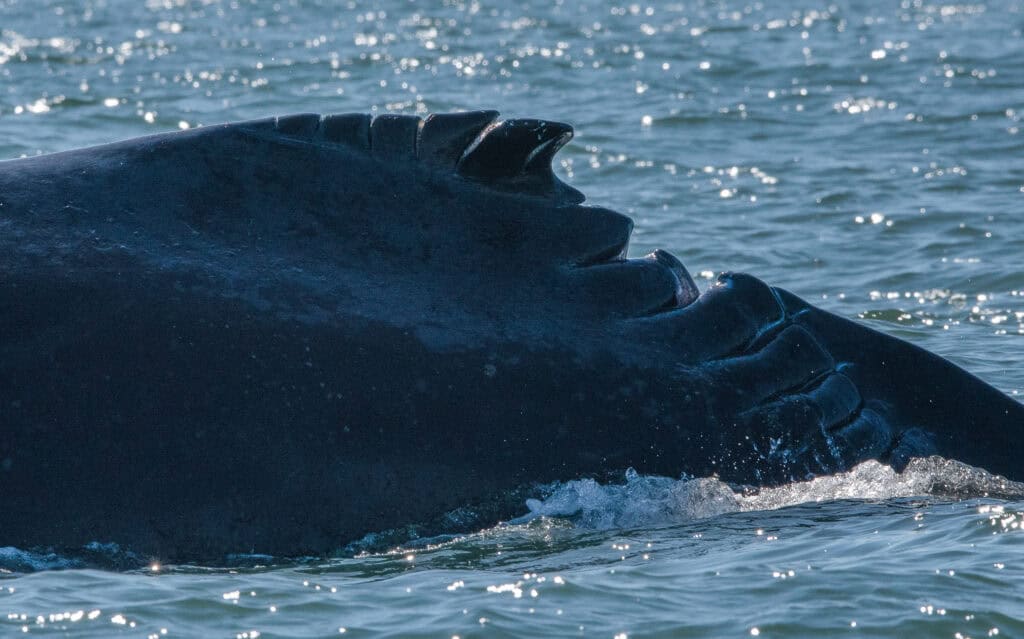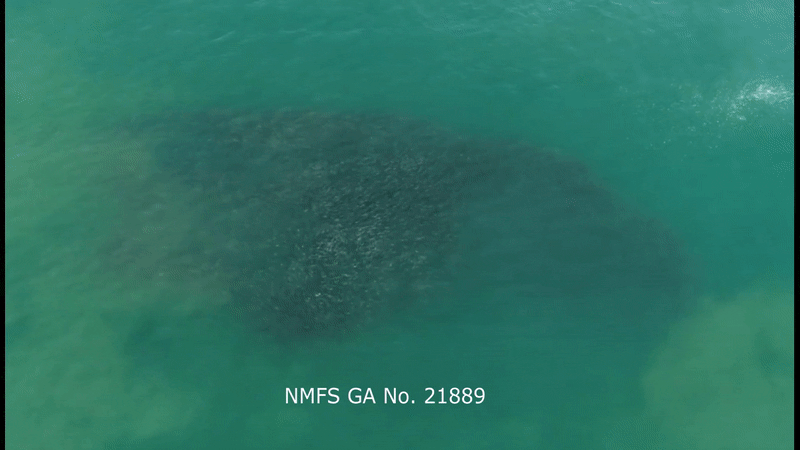Juvenile humpback whales in the New York Bight are more likely than adults to have scarring from vessel strikes. The vast majority of all whales, regardless of age class, have scars from fishing gear entanglement.
“We already knew that New York has become a hot spot for vessel strikes, so this is another piece of evidence in that line,” said Lesley Thorne, a marine ecologist at Stony Brook University. “It goes to show just how frequently humpbacks are interacting with human threats.”
In a new study in PLOS One, Thorne and her colleagues used drones to observe whales off the coast of New York and New Jersey. Each whale fluke, or tail fin, as seen below, is as unique as a fingerprint. The drone images helped the researchers identify each individual whale and determine if it had any scarring consistent with vessel strikes or fishing gear entanglement.
Around 87% of all humpbacks had entanglement scars, typically caused by fishing gear like gillnets, lobster cages and crab pots wrapping or rubbing around the flukes.

While 14% of juveniles had vessel strike scars, only 2% of adults did, which showed a different pattern compared to prior studies in the Gulf of Maine. In that region, adults have more vessel scars than juveniles. This difference suggests that juvenile whales in New York may be obtaining the vessel strike scars locally, Thorne said. Just the same, she added that the numbers reported in the study are “an underestimate” of vessel strikes, as they didn’t include fatal strikes or internal blunt force injuries that didn’t cause scarring visible by drone.
Growing presence of whales in the New York Bight
Around 2016, whale deaths—particularly in juveniles—increased from Florida to Maine, and the National Oceanic and Atmospheric Association declared an Unusual Mortality Event for humpbacks in the Atlantic Ocean.

Baleen whales, which include humpbacks (Megaptera novaeangliae), blue whales (Balaenoptera musculus) and right whales (Eubalaena sp.), breed in warmer, lower-latitude waters and then migrate poleward for feeding, though some whales stay in higher-latitude feeding grounds year-round. Time on the feeding grounds is particularly important for humpback whales because they’re capital breeders, meaning they shore up their fat reserves in the summer to last through a season of breeding and fasting.
Whales weren’t a common sight in the New York/New Jersey Bight—bordered by New Jersey and the southern coast of Long Island—before 2011. Traditionally, the Gulf of Maine was considered the southernmost summer foraging area for these animals. But Thorne said that trend is changing. “You have whales using the New York region for foraging more than they used to, which happens to be the busiest port on the East Coast,” Thorne said.

She thinks their presence in New York is due to a couple of factors, including an increase in menhaden fish stocks, which are a key food source for these filter feeders. The humpback whale population in the Gulf of Maine has been growing over time, too. “It’s probably a combination of factors that has led to an increase of habitat use in New York,” she said.
As whales have become more present in the New York Bight, shipping traffic too has increased, creating a perfect storm for more potential conflict between whales and boats. Previous research from Thorne’s lab found that vessel strikes were a driving force behind the increase in humpback whale deaths that started about a decade ago. In New York waters, there have been 38 nearshore and 11 offshore deaths of humpback whales since 2016.
The striking scars of boat collisions
Thorne is like a marine detective, piecing together the evidence of what happened to these animals. She and her team rarely see an animal that is actively entangled, and they have never directly observed a whale being struck by a vessel. “You get pieces of evidence through strandings, or in this case, through scars on live animals,” she said.

Some of these scars can be intense, cutting out chunks of blubber and flesh that don’t grow back throughout a whale’s lifetime. Thorne said that propeller scars, as seen above, create regular cuts through the whale—studies with manatees (Trichechus sp.) compare the distance between slashes to infer the size of the vessel. Future studies could analyze drone imagery of scars to infer the size of the ships striking whales to understand what boats pose the highest risk, she added.
How whale behavior may hold some answers
Previous research out of Thorne’s lab has suggested that juvenile humpbacks in the New York Bight may be more vulnerable to vessel strikes because they tend to feed at the surface in shallow areas. “We get drone imagery of a lot of the whales that we study here in New York in incredibly shallow waters,” she said, adding that those spotted close to shore are almost all juveniles.

The reasons why juveniles tend to forage in shallower waters closer to the surface are unclear, but Thorne has a few potential hunches. It may be that they’re taking advantage of a niche that older whales are too large to reach. Adult whales are more likely than younger whales to have jaw scarring consistent with bottom-feeding behavior, indicating that this behavior is learned over time.
Additionally, killer whales (Orcinus orca), while infrequently observed in New York waters, primarily target young animals and occur closer to shore. Avoiding killer whale predators could partly drive inshore habitat use in juveniles, where they are at a higher risk of vessel strike.
Regardless of the reason why juvenile and adult humpbacks have different behaviors, there are real consequences. Riskier feeding behavior in juveniles may put them in harm’s way.
Though it can be hard to witness the often gruesome effects that entanglements and vessel strikes have on whales, Thorne likes to get out on the water as often as weather permits to track down New York’s whales. “Humpbacks are so acrobatic and dynamic to watch,” she said. “And there’s still so much we don’t know.”

This photo essay is part of an occasional series from The Wildlife Society featuring photos and video images of wildlife taken with camera traps and other equipment. Check out other entries in the series here. If you’re working on an interesting camera trap research project or one that has a series of good photos you’d like to share, email Olivia Milloway at omilloway@wildlife.org.




